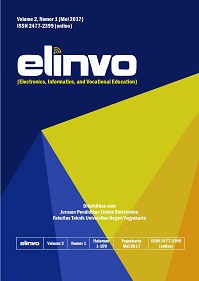Topik Modeling Penelitian Dosen JPTEI UNY Pada Google Scholar Menggunakan Latent Dirichlet Allocation
DOI:
https://doi.org/10.21831/elinvo.v4i2.28254Keywords:
clustering, LDA, research, topic modelingAbstract
The mapping of research topics for lecturers is necessary to determine the research tendencies in a department or study program. This study aims to implement topic modeling in the publication titles of the Department of Electronics and Informatics Education Engineering of Universitas Negeri Yogyakarta (JPTEI UNY) lecturers taken from Google Scholar. The method used for topic modeling is the Latent Dirichlet Allocation (LDA). LDA is a generative probabilistic model for finding the semantic structure of a corpus collection based on the hierarchical bayesian analysis. After the topic modeling process, the results showed that JPTEI UNY lecturers tend to have four research clusters consisting of vocational education, system development, learning media, and vocational learning systems.
References
R. Alghamdi and K. Alfalqi, "A Survey of Topic Modeling in Text Mining," Int. J. Adv. Comput. Sci. Appl., vol. 6, no. 1, pp. 147–153, 2015.
A. F. Hidayatullah, S. K. Aditya, Karimah, and S. T. Gardini, "Topic modeling of weather and climate condition on twitter using latent dirichlet allocation (LDA)," IOP Conf. Ser. Mater. Sci. Eng., vol. 482, no. 1, 2019.
K. Bastani, H. Namavari, and J. Shaffer, "Latent Dirichlet allocation (LDA) for topic modeling of the CFPB consumer complaints," Expert Syst. Appl., vol. 127, pp. 256–271, 2019.
Y. Wang and J. E. Taylor, "DUET: Data-Driven Approach Based on Latent Dirichlet Allocation TopicModeling," J. Comput. Civ. Eng., vol. 33, no. 3, 2019.
S. Joo, I. Choi, and N. Choi, "Topic analysis of the research domain in knowledge organization: A latent dirichlet allocation approach," Knowl. Organ., vol. 45, no. 2, pp. 170–183, 2018.
S. W.Kim and J. M. Gil, "Research paper classification systems based on TF-IDF and LDA schemes," Human-centric Comput. Inf. Sci., vol. 9, no. 1, 2019.
S. Zoghbi, I. Vulić, and M. F. Moens, "Latent Dirichlet allocation for linking user-generated content ande-commerce data," Inf. Sci. (Ny)., vol. 367–368, pp. 573–599, 2016.
J. C. L. Pinto and T. Chahed, "Modeling multi-topic information diffusion in social networks using latent dirichlet allocation and hawkes processes," Proc. -10th Int. Conf. Signal-Image Technol. Internet-Based Syst. SITIS 2014, pp. 339–346, 2015.
D. Yokomoto et al., "LDA-based topic modeling in labeling blog posts with wikipedia entries," Lect. Notes Comput. Sci. (including Subser. Lect. Notes Artif. Intell. Lect. Notes Bioinformatics), vol. 7234 LNCS, pp. 114–124, 2012.
D. Zha and C. Li, "Multi-label dataless text classification with topic modeling," Knowl. Inf. Syst., vol. 61, no. 1, pp. 137–160, 2019.
H. Jelodar et al., "Latent Dirichlet allocation (LDA) and topic modeling: models, applications, a survey," Multimed. Tools Appl., vol. 78, no. 11, pp. 15169–15211, 2019
Downloads
Published
How to Cite
Issue
Section
Citation Check
License
The article published in ELINVO became ELINVO's right in publication.
This work by ELINVO is licensed under a Creative Commons Attribution-NonCommercial 4.0 International License.









